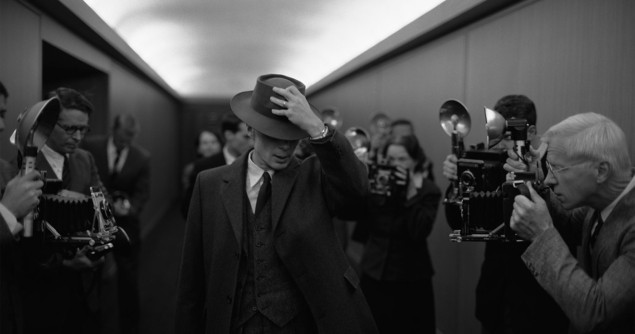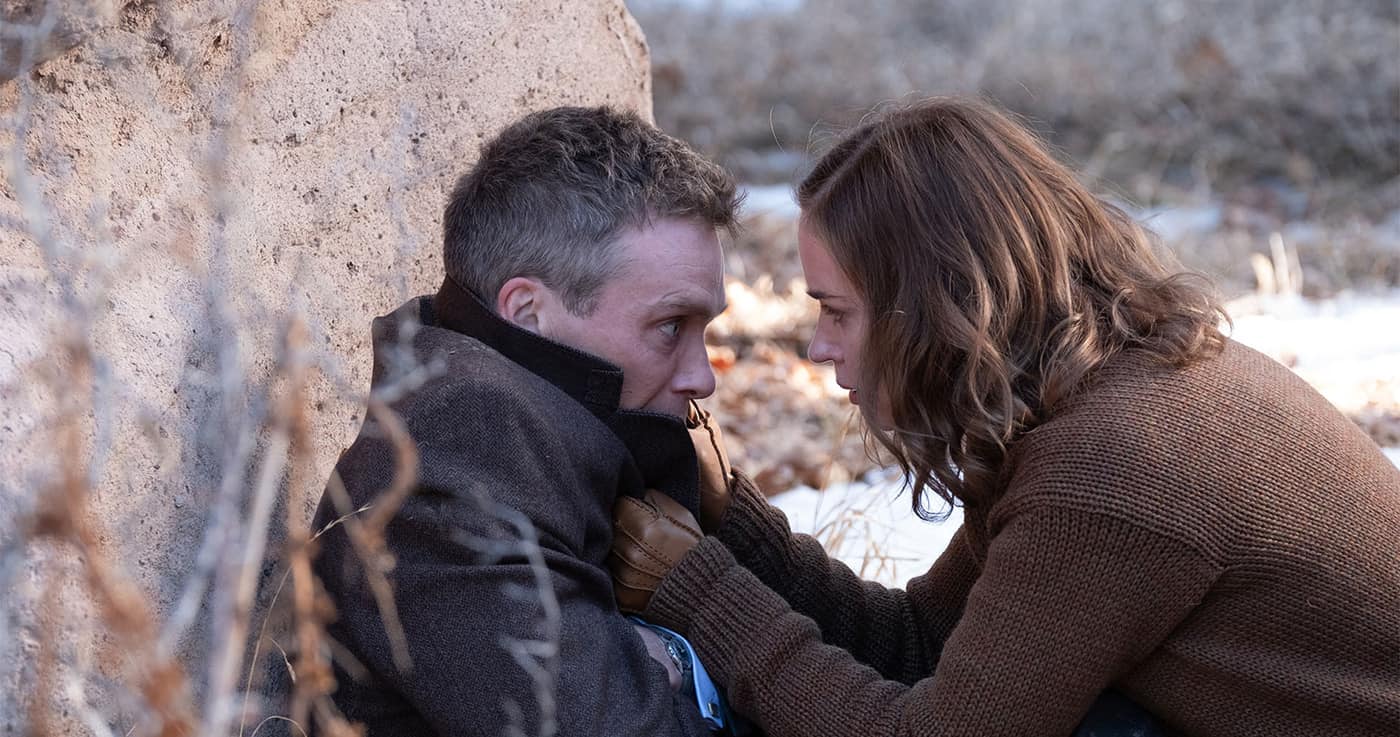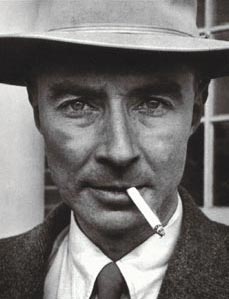Andrew Glester reviews the film Oppenheimer, written and directed by Christopher Nolan

When Christopher Nolan (Interstellar, Memento, TENET) makes a film about J Robert Oppenheimer, the father of the atomic bomb, you expect it to be spectacular. With a runtime of three hours, the simply titled Oppenheimer is expansive in every aspect. Indeed, new film stock had to be made to shoot the black-and-white sequences for gigantic IMAX screens.
From sequences that visualize quantum physics to those depicting the titular character’s mental state soon after the devastating explosions of atomic bombs – not to mention the actual Trinity test – the film is a visual masterpiece. But much of it is dialogue-based, with the drama coming from political machinations, in a world dealing with the fallout of the Second World War.
I first saw Oppenheimer in the IMAX at the Science Museum in London and then for a second time in a small, seaside cinema in Devon, UK. On an ordinary cinema screen, it is staggering. On an IMAX, it is visceral. This is no surprise as Nolan is an expert of IMAX and although this film, with its concentration on politics, is closer to The West Wing than Interstellar, in his hands, the immense format leads to total immersion in the world and its characters. Add an exceptional performance by Cillian Murphy in the role of Oppenheimer and a typically Nolan time-bending narrative, and it is no wonder that audiences have flocked to IMAX screens to take it all in.
Nolan’s films rarely follow a straight story arc. Narratively, there are two main strands: the early-career scientist Oppenheimer, and the embattled, politics-laden administrator of the 1950s. Between them is the story’s fulcrum – the atomic bomb development in Los Alamos, New Mexico. In the former, Oppenheimer’s focus, and that of the film, is physics. Patrick Blackett, Niels Bohr, Isidor Rabi and Werner Heisenberg all feature. Later, everything turns to politics, just as Oppenheimer’s career did, as he sought to use his notoriety as the father of the atomic bomb to try to influence nuclear policy in the US.

Oppenheimer the movie: Physics World writers give their verdict
This political strand centres around trial-like proceedings that were held when Lewis Strauss (played by Robert Downey Jr, another formidable performance), chair of the Atomic Energy Commission, sought to remove Oppenheimer’s security clearance in 1954. Unusually, the whole film script – which includes not just the dialogue but also the stage directions, actions, expressions and so on – was written in the first person to aid those reading it to feel the intense focus of the film on Oppenheimer the man. Apart from Oppenheimer and Strauss, other key physicists such as Ernest Lawrence (Josh Hartnett), Edward Teller (Benny Safdie) and Hans Bethe (Gustaf Skarsgård) play key roles.
The film also focuses on key figures from Oppenheimer’s personal life, including his long-time partner Jean Tatlock (Florence Pugh) and his wife Kitty (Emily Blunt). The latter was a fascinating character, and Blunt does a wonderful job in portraying this complex woman. A scientist herself, Kitty was a trained biologist and chemist and prior to meeting Oppenheimer, she worked at the Caltech X-ray lab, with physicist Charles Lauritsen, on experimental cancer therapy. Later, at Los Alamos, Kitty worked in the health group, conducting blood tests to assess the danger of radiation. None of this is included in the film, which instead only focuses on the pair’s passionate and often tumultuous relationship. In a film with so few female scientists represented, this seems to be an unfortunate omission.

Nolan uses a mixture of colour and black-and-white film to illustrate the two perspectives. The subjective, where we are seeing the world from Oppenheimer’s perspective, is in colour. The objective, largely in terms of how he is seen by Strauss, is in black and white. As with Interstellar, physics and storytelling collide and use one another in key aspects of the narrative.
The film begins by immersing the audience deeply in the most significant fundamental physics discoveries of the time – from nuclear and particle physics to quantum mechanics, which was a radical new way to consider the world around us. In a scene that Nolan has likened to Luke Skywalker meeting Obi Wan Kenobi in Star Wars, a young Oppenheimer meets the celebrated Bohr. In a later period, an older Oppenheimer meets his acquaintance Albert Einstein at the Institute for Advanced Study in Princeton, when the former moved there to serve as director from 1947 until 1966.
Alongside these scenes, we are treated to visualizations of waveforms and particle behaviour, giving the audience a sense of what it might feel like to consider matter in this way. Visually, this metaphor continues throughout the film and, ultimately, to the destruction of that matter.
We never see the true devastation of the two atomic bombs dropped on the Japanese cities of Nagasaki and Hiroshima, but Nolan visualizes the horror through Oppenheimer’s imagination in an aurally and visually hard-hitting thread that runs throughout the film. In one of the film’s most jarring scenes, as the scientists and others at Los Alamos “celebrate” the dropping of atomic bombs (and thus the end of the Second World War with Japan’s surrender), Oppenheimer envisions the horrifying impact of the bombs on people, all while giving a celebratory speech. This signifies his early misgivings despite his work on making the atomic bomb a reality.
The big questions of the film are left for the audience to decide. Nolan is not a didactic storyteller
Murphy’s face – gaunt and haunted – fills the screen and his likeness to Oppenheimer is striking as we see him try to come to terms with what he must create (in the earlier timeline) and has successfully created (in the later). It is, however, impossible to know for sure what Oppenheimer truly felt about his role in the Manhattan Project. Asked by CBS in 1965 whether dropping the atomic bomb was necessary, he concluded “I have not a very good answer to this question.” This uncertainty is core to the Oppenheimer script. The big questions of the film are left for the audience to decide. Nolan is not a didactic storyteller.
Oppenheimer does not end with the dropping of the bombs – in fact much of the weight of his story comes after the fact. In the 1950s the Republican senator Joseph McCarthy led a campaign against leftist members of the American community, with many of them losing their jobs under accusations of being members of the Communist Party. In many cases, they were not. This McCarthyism was meted upon Oppenheimer, and Nolan’s film sees the politicians, especially Strauss, trying to bring him down.
One effect of the interwoven timelines is that we are confronted with people celebrating a man for his role in the mass killing of civilians and vilifying him for having left-wing sentiments. It’s a rare moment where there are clear good guys and bad guys, but for the most part Nolan’s characters are flawed and troubled.
In that courtroom-esque drama, the politicians are trying to remove Oppenheimer from their plans to build an even more monstrous weapon – the hydrogen bomb. Oppenheimer was aware that the Second World War was effectively over at the time the two atomic bombs were dropped on Japan – the Nazis had already surrendered and the Japanese were close to beaten.
After that, Oppenheimer was of the firm opinion that there was no justification, and no military target big enough, to justify the hydrogen bomb. His fear stemmed from the realization that humanity – or at least the politicians among us – would use any bomb they have built, no matter how big. Those politicians effectively use his left-leaning political views to remove him, and his objections, from the project.

A life of genius and tragedy
The argument for nuclear weapons is that they form a deterrent. Whether the deterrent has worked or not is an open question. The people of Ukraine might have a different point of view from that of Vladimir Putin, for example. War certainly has not stopped. In an ideal world, these bombs would never have been made but, as the film makes clear, this is not realistic. The discovery of the immense power of the atom could not have been kept secret. That simply is not how science works. Whether there was ever a need to use it on people is quite another question.
One physics detail explored in the film is Teller’s calculations that the detonation of the atomic bomb might set off a chain reaction that would ignite the entire Earth’s atmosphere. Teller theorized that temperatures created by a nuclear fission bomb might be so extreme that they would fuse hydrogen atoms together, as in the heart of our Sun. If true, this might have caused a chain reaction that would engulf the planet, vaporize the oceans and extinguish all life. The scientists at Los Alamos knew that there was a negligible, but non-zero possibility the bomb would set alight the atmosphere in an uncontrollable runaway effect. They, and the politicians and generals in charge, still pressed the button.
“Are you saying there’s a chance we destroy the world?” General Groves (Matt Damon) asks Oppenheimer. In creating this film, Christopher Nolan asks that question anew.
- 2023 Universal Pictures
- SEO Powered Content & PR Distribution. Get Amplified Today.
- PlatoData.Network Vertical Generative Ai. Empower Yourself. Access Here.
- PlatoAiStream. Web3 Intelligence. Knowledge Amplified. Access Here.
- PlatoESG. Automotive / EVs, Carbon, CleanTech, Energy, Environment, Solar, Waste Management. Access Here.
- PlatoHealth. Biotech and Clinical Trials Intelligence. Access Here.
- ChartPrime. Elevate your Trading Game with ChartPrime. Access Here.
- BlockOffsets. Modernizing Environmental Offset Ownership. Access Here.
- Source: https://physicsworld.com/a/beyond-the-bomb-the-life-and-times-of-j-robert-oppenheimer/
- :has
- :is
- :not
- :where
- 160
- a
- About
- Accusations
- actions
- actual
- add
- advanced
- After
- against
- Aid
- All
- already
- also
- Although
- American
- among
- among us
- an
- and
- Another
- answer
- any
- apart
- Arc
- ARE
- argument
- around
- AS
- aspect
- aspects
- assess
- At
- Atmosphere
- atom
- audience
- audiences
- aware
- Bad
- BE
- been
- being
- between
- Beyond
- Big
- Black
- blood
- bomb
- bring
- build
- built
- but
- button
- by
- calculations
- Campaign
- Cancer
- cancer therapy
- Career
- cases
- caused
- celebrated
- Celebrating
- centres
- certainly
- chain
- Chair
- Chance
- changing
- character
- characters
- charge
- Christopher
- Cinema
- Cities
- civilians
- clear
- clearance
- click
- Close
- closer
- Collide
- come
- comes
- coming
- commission
- community
- complex
- complexity
- concentration
- concluded
- conducting
- Consider
- continues
- Core
- could
- create
- created
- Creating
- DANGER
- dealing
- decide
- depicting
- Despite
- destroy
- detail
- devastating
- devastation
- Development
- dialogue
- DID
- different
- Director
- discovery
- does
- down
- Drama
- dropped
- Dropping
- Earlier
- Early
- Edward
- effect
- effectively
- einstein
- end
- energy
- enough
- Entire
- envisions
- especially
- Even
- EVER
- Every
- everything
- example
- exceptional
- expansive
- expect
- experimental
- expert
- Explored
- explosions
- expressions
- extreme
- Face
- fact
- fallout
- fascinating
- fear
- Feature
- feel
- female
- few
- Figure
- Figures
- Film
- films
- Firm
- First
- flawed
- Focus
- focuses
- follow
- For
- form
- format
- Former
- formidable
- from
- fundamental
- General
- genius
- Give
- Giving
- good
- Group
- had
- Hands
- Have
- having
- he
- Health
- Heart
- Held
- him
- his
- holding
- horrifying
- horror
- HOURS
- How
- However
- HTTPS
- Humanity
- hydrogen
- ideal
- if
- Ignite
- image
- imagination
- immense
- Impact
- impossible
- in
- included
- Including
- indeed
- influence
- information
- instead
- Institute
- issue
- IT
- ITS
- Japan
- Japan’s
- Japanese
- Job
- Jobs
- jpg
- just
- kept
- Key
- Know
- lab
- largely
- later
- lawrence
- Leads
- least
- Led
- left
- Life
- like
- los
- losing
- made
- Main
- MAKES
- Making
- man
- many
- Mass
- masterpiece
- Matt Damon
- Matter
- max-width
- mechanics
- meeting
- Meets
- Members
- mental
- Mexico
- might
- Military
- mixture
- moment
- more
- most
- moved
- movie
- much
- Museum
- must
- NARRATIVE
- Need
- never
- New
- no
- None
- nuclear
- objective
- of
- off
- often
- on
- ONE
- only
- open
- Opinion
- or
- ordinary
- Other
- Others
- our
- over
- part
- partner
- party
- passionate
- patrick
- People
- performance
- period
- person
- personal
- perspective
- perspectives
- Physics
- Physics World
- Pictures
- planet
- plans
- plato
- Plato Data Intelligence
- PlatoData
- Play
- played
- plays
- Point
- Point of View
- policy
- political
- Politicians
- politics
- possibility
- power
- press
- Princeton
- Prior
- Proceedings
- project
- Putin
- Quantum
- Quantum Mechanics
- quantum physics
- question
- Questions
- radical
- RARE
- rarely
- reaction
- Reading
- realistic
- Reality
- realization
- relationship
- remove
- represented
- Republican
- Reveals
- Reviews
- ROBERT
- Role
- roles
- runs
- s
- saw
- saying
- scene
- scenes
- Science
- scientific
- Scientist
- scientists
- Screen
- screens
- Second
- Second world war
- Secret
- security
- see
- seeing
- seems
- seen
- sees
- Senator
- sense
- sentiments
- serve
- set
- she
- Shoot
- significant
- signifies
- simply
- small
- So
- soon
- sought
- spectacular
- speech
- Stage
- State
- stemmed
- Still
- stock
- stopped
- Story
- storytelling
- straight
- Strands
- Study
- Successfully
- such
- Sun
- sure
- surprise
- surrounded
- Take
- Target
- terms
- test
- tests
- than
- that
- The
- the world
- their
- Them
- then
- There.
- These
- they
- this
- those
- three
- Through
- throughout
- thumbnail
- Thus
- time
- timeline
- timelines
- times
- titled
- to
- together
- Total
- trained
- Trinity
- true
- truly
- try
- turns
- two
- typically
- Uk
- Ukraine
- Ultimately
- Uncertainty
- under
- unfortunate
- Universal
- until
- upon
- us
- use
- uses
- very
- View
- views
- Vladimir Putin
- war
- was
- Way..
- we
- Weapons
- weight
- WELL
- were
- West
- What
- when
- whether
- which
- while
- white
- whole
- wife
- Wikipedia
- with
- woman
- wonderful
- Work
- worked
- works
- world
- would
- written
- x-ray
- You
- young
- youtube
- zephyrnet













